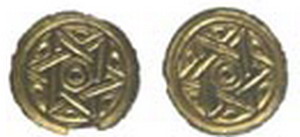BARS-14
Brit-Am Research Sources.
A collection of informational leads for further study.
2 January 2012, 7 Tevet 5772.
Contents:
1. National Identities:
Migration of the Nations #1 Where the nations of Gen.10 are today
by Harold Hemenway
2. Bob Davis: Anglo-Saxon Brooches with the Star of David.
3. Does the Yiddish Language Derive from Gothic?
4. THE JEWISH ROOTS OF THE NOBILITY OF EUROPE
5. The Phoenician Origins of Runic Script.
|
Brit-Am Discussion Group |
Contents by Subject |
Research Recognition Reconciliation Contribute |
|
Site Map Contents in Alphabetical Order |
This Site |
1. National Identities:
Migration of the Nations #1
Where the nations of Gen.10 are today
by Harold Hemenway
http://www.keithhunt.com/Nations1.html
This site contains much useful information.
That does not mean that it is all correct or that we agree with any of it.
In fact there are some pojnts we found offensive.
Nevertheless it may be worth looking at.
2. Bob Davis: Anglo-Saxon Brooches with the Star of David.
Dear Yair
I saw these two brooches yesterday, from an Anglo-Saxon burial ground. They are displayed in the in the Museum of London. I thought you would be interested if you have not already seen them,
Regards
Bob Davis
http://www.museumoflondon.org.uk/
London-Wall/Whats-on/Galleries/
medieval/objects/record.htm'type=
object&id=743391
Pair of brooches
|
Date: 500s
Text:
Men and women both wore brooches, like large safety pins, to fasten their clothes. They were often worn in pairs on the shoulders. Only the rich could afford brooches made of gold or silver. These were found in a grave in the Anglo-Saxon cemetery at Mitcham, near the neck of a fragmentary skeleton, and are made of copper-alloy covered in gold (gilded). They have an unusual 'Star of David' design. Also found was an iron knife at the skeleton's waist and an ivory ring on the forearm.
3. Does the Yiddish Language Derive from Gothic?
http://www.gothicyiddish.blogspot.com/
Extracts:
...early Yiddish was an East Germanic language derived from Gothic...
As to the question of how the original Gothic-derived Yiddish got to Austria, I currently favor the hypothesis that from at least 500 CE on, Gothic was spoken by the Jews of northwestern Balkan Jewry. Medieval Austria was settled by Jews from the Rhineland and East Franconia as well as other areas but I think that early Yiddish was brought there by settlers from the area of the Sava River [tributary of the Danube, Balkan Region of eastern Europe] valley.
4. THE JEWISH ROOTS OF THE NOBILITY OF EUROPE
http://jatistan.blogspot.com/
2010/11/jewish-roots-of-nobility
-of-europe.html
Extract:
Irish historian Thomas Moore writes: 'It is indeed evident that those persons to whom St. Patrick [A.D. 400s] applies the name Scots, were all of the high and dominant class; whereas, when speaking of the great bulk of the people, he calles them Hiberionaces, from the name Hiberione, which is always applied by him to the island itself' (1837, Vol. 1, p. 72).
Dr. James Wylie explained: 'The Scots are the military class; they are the nobles . . . The latter [the Hiberni] are spoken of as the commonality, the sons of the soil' (History of the Scottish Nation,1886, p. 281). Wylie also adds: 'St. Patrick often uses Scoti and Reguli [princes] as equivalent terms. To the term Scottus he adds often the word Nobilis; whereas he has no other appellative for the native Irish but Hyberione, or Hyberni genae, the common people' (p. 282 footnote). The early Scot overlords were Jewish. The common people of Ireland were simply Hiberni or Hebrews, the tribe of Dan. And it was the aristocracy that the Irish royalty intermarried.
5. The Phoenician Origins of Runic Script
From: GardenStone
Subject: Re: [Germanic-L] Re: The Goths and the Futhark
> Looijenga's hypothesis is that runes were developed from italic scripts by > Scandinavian mercenaries serving on the Rhine Limes.
In 2006, so nine years later, Theo Vennemann, philologist and linguist publiced his thesis "Germanische Runen und phoenizisches Alphabet",
in the periodical Sprachwissenschaft 34, 367-429.
A short German abstract was in the press release at:
http://idw-online.de/pages/en/
news'print=1&id=186908
This Phoenician theory isn't really new, but by Vennemann's linguistic contribution it became quite some more plausibility.
The German article isn't online, but I made a quick and dirty scan of the short English abstract:
The poblem of the origin of the Germaine runes and the runic writing system is considered unsolved. Many aspects of the runes are enigmatic even for the most widely accepted thesis, that of the Latin origin of the runes. The present article develops the thesis that runic writing derives directly from the Phoenician writing system of the Carthaginians who dominated the Atlantic coasts from the fifth to the end of the third century, rather than via Greek, Etruscan, or Latin. This thesis explains all the distinctive properties of runic writing: the form of those runes for which Latin offers no model; the acrophonic naming of the runes with appellatives; various aspects of the order of the older futhark, especially the beginning with a rune named lehu `cattle'; the frequent use of scriptura continua; the omission of nasals before homorganic consonants; the writing of gemimtes with single rather than double consonants. Most importantly, the Phoenician thesis explains the concentration of the oldest runic fmds in the Scandinavian regions between the German and the Baltic Seas rather than close to the Roman Empire and answers the question of the reasons for the extraordinarily early availability of an alphabetic writing system of its own in northem Europe.

Pleased with what you have read?
Click Here to make an offering. |
'It is impossible to rightly govern the world without God or the Bible.'
George Washington
Brit-Am is the "still small voice" that contains the truth.
[1-Kings 19:12] AND AFTER THE EARTHQUAKE A FIRE; BUT THE LORD WAS NOT IN THE FIRE: AND AFTER THE FIRE A STILL SMALL VOICE.
 |
 |

